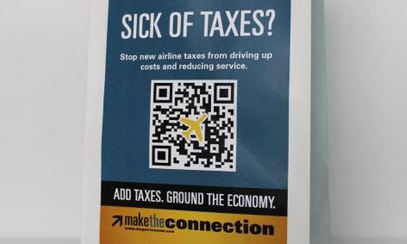
Today is a rough day for the airline industry.
To start, it's Tax Day, perhaps the industry's least favorite day of the year considering that airlines and their customers pay more special taxes and fees to government authorities than any other industry. (Take a look at all of the taxes levied by the government on the highly-regulated industry here.)
And then there is the story about U.S. Airways' pornographic tweet that was errantly sent out to one of its customers, unquestionably one of the worst Twitter blunders of all time.
It seems that the airline industry is always in need of some top-notch PR.
That was the case in 2011, when the industry was fighting against a new federal tax initiative that would add a mandatory $100 charge for every airplane that departed in controlled airspace.
To motivate public opinion against the proposed tax, Airlines for America (A4A), the industry's only trade organization, tapped APCO Worldwide's creative group to produce advertising and other communications collateral. The anti-tax PR campaign was eventually successful, as A4A and APCO Worldwide combined the power of both creative and traditional PR techniques to mobilize the public against the tax initiative.
As the lines between marketing and PR continue to blur, here are some tips on integrating creative with traditional PR from Tracy Phillips, associate director and senior graphic designer at APCO:
- Form follows function, most of the time. From day one, APCO wanted to use airsickness bags somehow, just not for their intended purpose. Use items creatively, especially ones related to your industry/issue, to act as a vehicle for a message to generate big buzz.
- Palettes with purpose. In the branding, APCO used colors seen in cautionary signage—yellows and blacks—an an appropriate palette, since A4A was warning the audience of potential downfalls of adding more taxes. “Incorporate striking color combinations to draw attention in print/ web, amidst the sea of typical policy-focused ads,” Phillips says.
- Big message. Concise copy. A4A had an important message for the audience and wanted them to take action quickly. APCO kept it simple but prominent in the design: “ADD TAXES, LOSE JOBS. STOP AIR TAX NOW.” Don’t make your audience hunt for what you want to say. You’ll lose them long before the call to action.
Follow Brian Greene: @bwilliamgreene

One response to “Integrating Creative Design and Traditional PR Techniques”